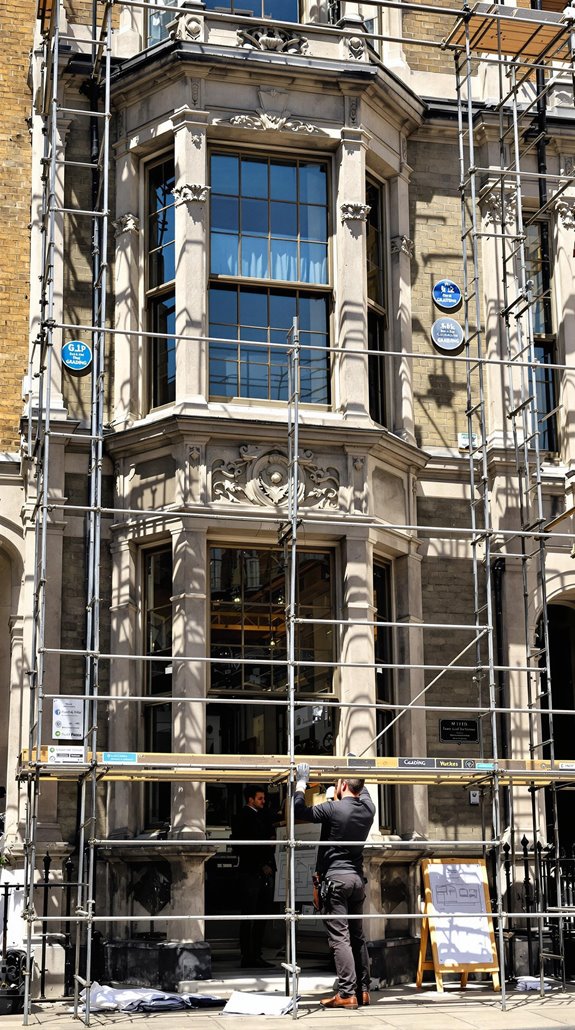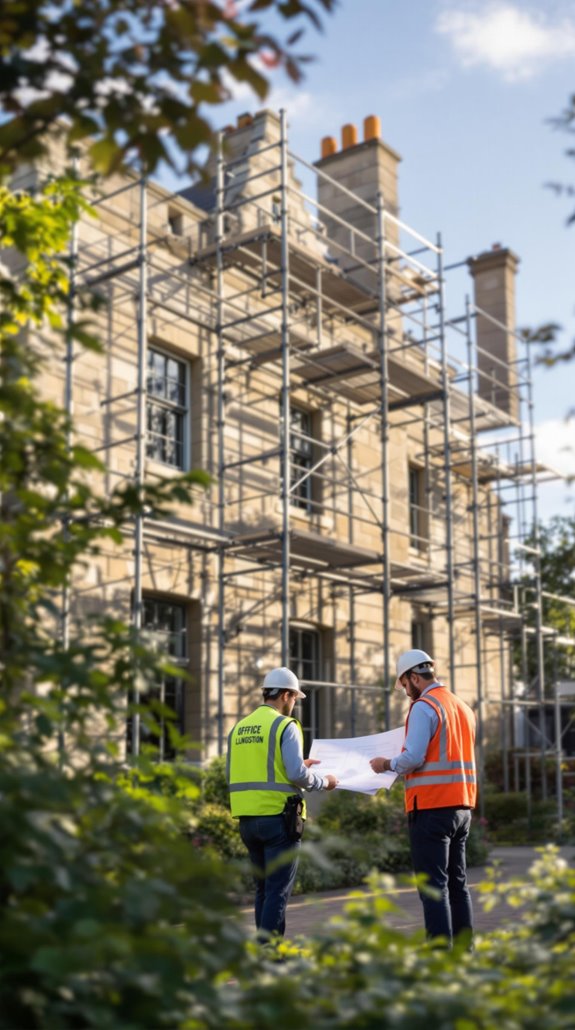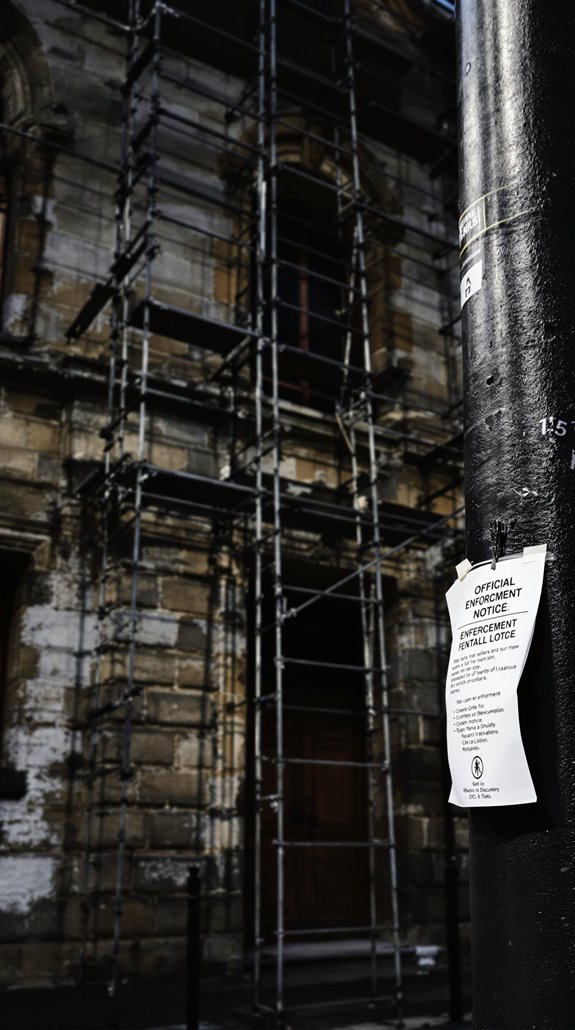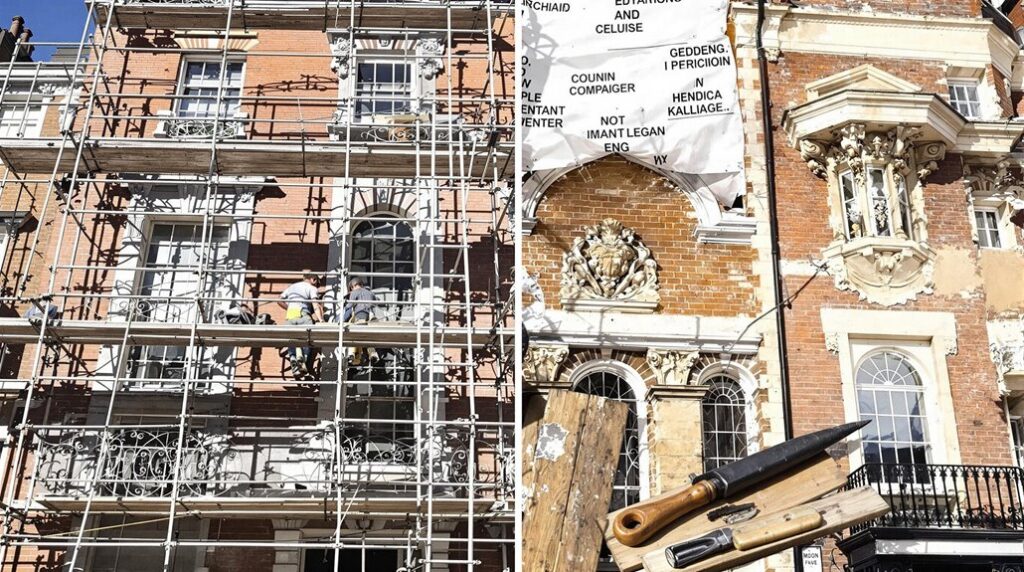I’ve watched countless homeowners make costly mistakes when renovating listed buildings—mistakes that could’ve been avoided with proper knowledge. The rules governing heritage properties aren’t just bureaucratic red tape; they’re legal requirements that can make or break your project. Before you pick up that sledgehammer or call your contractor, there’s a specific process you must follow. Skip these steps, and you’ll face enforcement action that could cost you thousands more than doing it right the first time.
Key Takeaways
- Always obtain listed building consent before alterations – unauthorized work is a criminal offense punishable by imprisonment and unlimited fines.
- Like-for-like repairs using original materials and interior changes preserving historic features typically don’t require consent.
- Use traditional materials only: lime mortar for masonry, period-matched timber, handcrafted window frames, and breathable lime-based paints.
- Consult Conservation Officers early and hire conservation-accredited specialists with proven listed building restoration experience.
- Focus on reversible modifications and prioritize maintenance over major alterations to satisfy planning authorities.
Understanding Your Building’s Grade Classification and Legal Requirements

When you own or are considering purchasing a listed building, you’ll need to understand exactly which grade classification applies and what legal obligations come with it.
In England, there are three distinct grades: Grade I represents buildings of exceptional interest (only 2.5% of listings), Grade II* covers particularly important buildings of special interest (5.8% of listings), and Grade II encompasses buildings of special interest (91.7% of listings).
Your building’s grade directly impacts renovation restrictions and approval processes. Higher grades face stricter scrutiny and preservation requirements. All listed buildings require listed building consent for alterations, but Grade I properties undergo the most rigorous assessment.
Check your local planning authority’s records to confirm your building’s exact grade classification—this determines your legal framework for any future modifications. These records provide essential insights into local history and culture that can guide your renovation decisions.
Navigating the Listed Building Consent Application Process
Before making any alterations to your listed building, you’ll need to secure listed building consent through a structured application process with your local planning authority. I’ll walk you through the essential steps that fellow property owners have successfully navigated.
Start by consulting your Conservation Officer—they’ll determine if consent’s actually needed and provide invaluable guidance on acceptable approaches. Don’t skip this vital step; their expertise can save you months of revisions.
When applying, use your local authority’s online portal for fastest processing. Include thorough documentation: site plans, photographs, heritage statements, and detailed drawings. Standard processing takes 8 weeks, extending to 12 weeks for Grade I and II* buildings.
Remember: unauthorized work constitutes a criminal offense. Your planning authority can prosecute or force work reversal, so patience pays off. One advantage of the listed building consent process is that there’s no fee for the application itself.
What Renovations You Can Actually Do Without Breaking Rules

While listed building consent protects historic properties, you can still tackle numerous renovation projects without triggering legal complications. I’ll walk you through what’s actually allowed so you can confidently maintain your historic home.
You can perform like-for-like repairs using original materials and traditional methods. This includes fixing sash windows, repairing gutters with matching materials, and repainting exteriors in identical colors. Inside, you’re free to replace modern kitchens and non-historic bathroom fixtures, provided you preserve room sizes and historic features. Additionally, consider using fire resistant plasterboard to enhance safety during renovations, especially in areas requiring fire protection.
Here’s your golden rule: keep everything reversible. Install hidden wiring, swap modern appliances, and redecorate freely—just don’t damage the historic fabric. Focus on maintenance over modification, and you’ll keep both your property and the authorities happy while creating the home you want. Remember that specialist heritage insurance is crucial during any renovation work to protect against unique risks that standard policies won’t cover.
Essential Material Requirements for Historical Accuracy
Getting your materials right makes the difference between a successful renovation and a costly rejection from conservation officers. I’ll walk you through the non-negotiables that’ll keep your project on track.
For masonry work, you must use lime mortar instead of cement. Modern cement’s rigidity causes cracking in historic walls, while lime allows natural expansion and moisture evaporation. Match your original composition exactly—hydraulic lime often works best for durability. Utilizing effective use of natural light can greatly enhance the overall atmosphere of your renovated space.
Timber repairs demand like-for-like replacement using traditional joinery techniques. Synthetic substitutes aren’t allowed; you’ll need period-matched or reclaimed wood. Use breathable treatments like linseed oil to prevent moisture trapping.
Windows require handcrafted timber frames matching original profiles. Splice repairs beat full replacements every time. For finishes, stick to breathable lime-based paints—modern vinyl paints are banned. Non-compliance with these material requirements can result in fines or penalties from heritage authorities.
Working With Conservation Officers and Planning Authorities

Success with listed building projects depends entirely on building strong relationships with conservation officers from day one. I’ll walk you through the essential steps that’ll keep your project on track.
Start by scheduling an informal consultation before submitting any applications. Conservation officers become your allies when you demonstrate respect for the building’s heritage. They’ll guide you on appropriate materials, techniques, and potential concerns specific to your property.
Submit detailed heritage impact assessments with your listed building consent applications. Include method statements for sensitive work like decorative restoration. Non-minor alterations require conservation-accredited professionals—don’t cut corners here.
Remember: structural changes, extensions, and feature alterations always need consent. Like-for-like repairs using original methods typically don’t. When in doubt, ask first—unauthorized work risks criminal charges.
Even internal modifications such as changing flooring or installing new fireplaces require listed building consent before any work begins.
Traditional Building Techniques You Must Follow
Because listed buildings were constructed using breathable materials and time-tested methods, you’ll need to abandon modern construction techniques and embrace traditional approaches that’ve kept these structures standing for centuries.
I’ll guide you through the essential techniques. Use lime mortar instead of cement – it allows natural expansion and prevents structural damage. Additionally, be aware that planning permission requirements can differ for listed buildings, making it crucial to consult local regulations before starting your project. Apply breathable paints on masonry and wood to avoid moisture entrapment. For walls, stick with natural stone or traditional bricks that maintain capillary action.
When working with timber frames, use traditional jointing rather than modern reinforcements. Install lime plaster internally to regulate humidity. Choose thatch, stone slate, or clay tiles for roofing.
Remember: these buildings need to “breathe.” Avoid synthetic barriers that trap moisture and cause long-term damage to your heritage property. These vernacular structures were built using local materials that varied by region based on availability and cost.
Enforcement Actions and Penalties for Non-Compliance

When you violate listed building regulations, you’re facing serious legal consequences that can devastate your finances and freedom. I’ll walk you through what enforcement actually looks like so you’re prepared.
First, you’ll face criminal prosecution under the Listed Building and Conservation Areas Act 1990. The maximum penalty hits hard: two years’ imprisonment plus unlimited fines. Courts regularly impose fines ranging from £500 to over £40,000, depending on your violation’s severity.
Here’s the enforcement process you’ll encounter: Local Planning Authorities issue enforcement notices requiring you to reverse unauthorized work. You can’t ignore these—they’re filed on Local Land Charges Register, affecting future property sales. If you don’t comply, councils will execute restoration work themselves and bill you for costs, which can exceed £450,000 for major violations. Remember that unauthorized works affecting the character of a listed building constitute an offence under Section 9 of the Planning Act 1990, regardless of the building’s grade level.
Finding the Right Specialists for Heritage Projects
After understanding the steep penalties for non-compliance, you’ll want to get your heritage project right the first time by selecting qualified specialists.
I recommend starting with FMB Master Builders who’ve passed independent vetting for quality work. Look for contractors with proven portfolios showcasing listed building restorations—churches, manors, and commercial properties demonstrate versatility you’ll need.
Your ideal specialist should master traditional craftsmanship: lime mortar applications, crown glass restoration, gauged brickwork, and leadwork. They’ll understand that heritage projects require breathable materials and minimally invasive techniques that preserve historic fabric.
Verify their credentials through trade body memberships and client testimonials specifically addressing heritage work. Check their experience with local planning authorities and conservation accreditation.
The right specialist coordinates specialist subcontractors and provides meticulous documentation for listed building consent processes. Working with historic buildings requires expert understanding of complex preservation requirements that differ significantly from standard construction projects.
Essential Resources and Documentation for Compliance

Once you’ve assembled your specialist team, you’ll need to navigate the documentation maze that governs listed building work. I’ll walk you through the essential paperwork that’ll keep you compliant.
First, gather your application essentials: completed forms, site plans, and scaled drawings showing both existing and proposed states. You’ll need labeled photographs of affected areas – these aren’t optional extras, they’re crucial for clarity.
Next, prepare your Heritage Statement detailing how your work impacts the building’s special interest. This document carries serious weight in decision-making.
Don’t skip the Certificate of Lawfulness application if you’re unsure whether consent’s required. It’s your safety net against costly mistakes.
Finally, organize pre-application consultations with your Conservation Officer. These meetings clarify requirements and streamline your approval process considerably. Remember that pre-application requests remain confidential and won’t be publicly disclosed unless legally required.
Conclusion
I’ve walked you through the essential steps for renovating your listed building legally. Now it’s time to put this knowledge into action. Start by checking your building’s grade classification, then contact your Conservation Officer before making any changes. Keep detailed records of all communications and approvals. Remember, investing in proper consent and skilled heritage professionals upfront will save you from costly enforcement actions and protect your property’s value long-term.
References
- https://www.insuremy.co.uk/guides/guide-to-renovating-listed-buildings-in-the-uk
- https://www.jamesclague.co.uk/news/listed-building-renovation-and-refurbishment-a-guide
- https://www.saundersbrothers.co.uk/post/listed-building-renovation
- https://www.gov.uk/government/publications/the-upkeep-and-repair-of-historic-buildings/the-upkeep-and-repair-of-historic-buildings
- https://www.squarepointsurveyors.co.uk/blog/listed-building-renovations-what-you-need-to-know/
- https://www.cia-landlords.co.uk/faq/what-are-the-different-categories-of-listed-buildings/
- https://en.wikipedia.org/wiki/Listed_building
- https://www.london-law.co.uk/listed-buildings-guide/
- https://www.gov.uk/government/publications/principles-of-selection-for-listing-buildings/principles-of-selection-for-listed-buildings
- https://historicengland.org.uk/listing/what-is-designation/listed-buildings/

